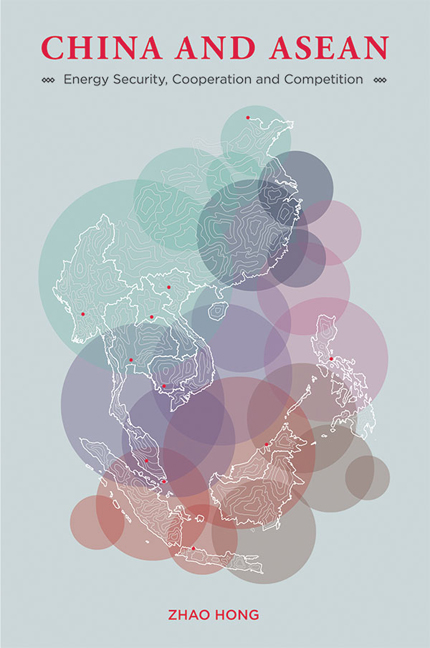Book contents
- Frontmatter
- Contents
- List of Tables and Figures
- List of Abbreviations
- Acknowledgements
- 1 Introduction: China, ASEAN, and the New Global Energy Order
- 2 Economic Growth and Energy Security
- 3 China's Energy Quest in Southeast Asia
- 4 Case Study (1): Myanmar
- 5 Case Study (2): Indonesia
- 6 Energy Resource Competition and the South China Sea Disputes
- 7 Conclusion
- Index
- About the Author
- Frontmatter
- Contents
- List of Tables and Figures
- List of Abbreviations
- Acknowledgements
- 1 Introduction: China, ASEAN, and the New Global Energy Order
- 2 Economic Growth and Energy Security
- 3 China's Energy Quest in Southeast Asia
- 4 Case Study (1): Myanmar
- 5 Case Study (2): Indonesia
- 6 Energy Resource Competition and the South China Sea Disputes
- 7 Conclusion
- Index
- About the Author
Summary
The twenty-first century is known to be the Asia century. The coming decades will see global economic growth increasingly being generated by Asian emerging economies. ASEAN is seeking to build political security and sociocultural communities as well as the economic community. With the rising population and economic growth resulting in an increasing share of global gross domestic product (GDP), Southeast Asia is seeing rapid growth in its energy demand and is consequently shifting the centre of gravity of world energy demand to Asia, along with its neighbours of China and India. These countries will account for an increasing share of international trade, investment flows, and energy resource demand. Such dramatic and rapid changes and shifts have created challenges in providing for energy resource supply, energy security, and environmental managements, as well as challenges to the international relations in the region.
COOPERATION OR CONFLICTS?
The previous chapters have analysed that, from an economic point of view, Asia is increasingly regarded as the most important region in the world. Indeed, it is widely thought to be the next most important focal point of the world economy that may soon replace the United States as the engine of global economic growth. The rise of China, the ASEAN Community, and other Asian countries like India economically has prompted East Asia to become the world's new economic centre of gravity and created a great impact on the world energy resource market, and will hence accelerate the changes in the world energy system, accelerating the energy shift from west to east.
In the background of rapid economic growth and increasing energy resource shortage, China's broader energy security strategy has been to pursue supply diversity, to find more and develop more offshore oil and gas resources in Southeast Asia. China has the intention to invest more on natural gas sectors in some ASEAN countries, such as Indonesia, Myanmar, and Malaysia. China expanded its foreign direct investment (FDI) to Southeast Asia after the global financial crisis in 2008, and China–ASEAN energy cooperation has developed to a new level, extending from energy trade to energy resource exploration and related infrastructure-building.
- Type
- Chapter
- Information
- China and ASEANEnergy Security, Cooperation and Competition, pp. 202 - 214Publisher: ISEAS–Yusof Ishak InstitutePrint publication year: 2015



